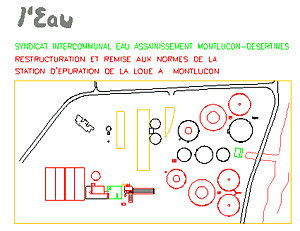1. Abstract
The European Union has launched a ambitious directive to treat all effluent before discharge in public waters. The water quality should comply to the directive by 2005, and will guarantee a sustainable clean water supply for generations to come.
The municipality of Montluçon (central France) rewarded the sludge incineration phase of the projected waste water treatment plant to SEGHERS in August 1999, and will be operational by the end 2000.
Municipal waste water sludge is still widely used as fertiliser, but ecological lobbying will soon ban this type of sludge disposal, because of leaching of various toxic elements into the groundwater.
2. Client's Requirements
The waste water treatment plant is a two stage anaerobic-aerobic system with a mechanical pretreatment. This system results in the highest effluent quality with the lowest process requirements.
The client wanted an in-house solution for all generated sludge and solids. The solution was to use the methane from the anaerobic treatment as a supporting fuel.
The waste profile for the degrader consists of :
1. Bottles, cans and other solids (>40mm), removed by the coarse sieve in the mechanical pretreatment.
2. Solids smaller than 40 mm removed by the fine sieve in the mechanical pretreatment.
3. Excessive sludge from the anaerobic reactor and from the thickener.
The proposed SEGHERSwaste degrader offers the flexibility regarding the waste profile, uses methane as auxiliary fuel, and complies to the strict French emission limits as outlined in the demanding public tender documents.

SEGHERSwaste-sludge degrader
The turnkey plant consists of a number of sub-elements:
Sludge reception, buffering and feedingReception and feeding of solids from fine sieveBasket feeding of solids from coarse sieveSEGHERSwaste degrader with air preheaterFlue gas cleaning system
4.1 Sludge reception and feeding
The external sludge is stored in an 7,5 m3 hopper. The bottom of the hopper consists of two shaftless screw conveyors that are continuously feeding the frequency controlled peristaltic pump. The pump outlet is connected with a flexible to the injection nozzle. The injection nozzle in the freeboard of the fluidised bed atomises the sludge with secondary combustion air.
4.2 Reception and feeding of solids from fine sieve
Solids from the fine sieve are stored in a 1 m3 hopper. The hopper is equipped with a shaftless conveyor screw to feed the waste into the SEGHERSdegrader. The waste is spread over the fluidized bed with an air knife of secondary combustion air.
4.3 Feeding of solids from the coarse sieve
The cans and bottles which are removed from the coarse sieve are discharged in a basket once per week. The basket is loaded with a hoist and trolley system in the fluidised bed. The water and organic matter is immediately volatized in the fluidized bed and the coarse sieve solids are reduced to a minimum of inert solid residu.
The process takes one hour, after which the basket with the remaining inert residu can be safely directed to a landfill.
The possibility of removing "larger" objects from the fluidized bed by means of a basket is only offered by SEGHERS.
4.4 SEGHERSwaste degrader with air preheater
The waste streams are fed at the preset rate into the fluidized bed, operating at 550 Co. The water is evaporated, the organic content decomposes and is partly combusted to CO2 and H2O and the inorganic fines are carried out of the fluidized bed with the air and flue gases.
Biogaz or methane from the bioreactor is used as a auxiliary combustible. Natural gas is added to the gasline in situations of higher gas requirements. To reduce the consumption of natural gas to a minimum, the secondary air is preheated by cooling of the flue gases in an heat exchanger. The heat exchanger leads to considerable energy savings.
All the gases arising from the fluidized bed are completely combusted in the second stage post-combustion chamber.
The temperature in the postcombustion chamber is controlled at 850°C and the oxygen concentration is controlled simultaneously. This garantees a complete combustion, excellent emissions and lowest gas consumption.
4.5 Flue gas cleaning system
A dry scrubbing system (AC) is installed to capture dioxins, acid gaseous effluents and volatile metals. The flow rate of the lime and AC is calculated from the elementary chemical composition of the waste.
The residual products after the dry scrubber and the inert ashes are separated in an absolute and temperature resistant ceramic fiber filter, developed and constructed by SEGHERS.
